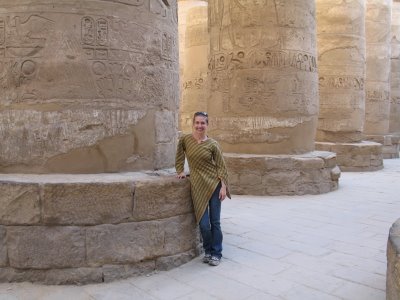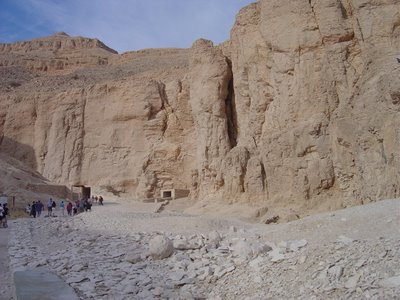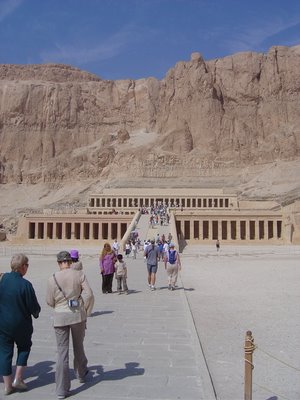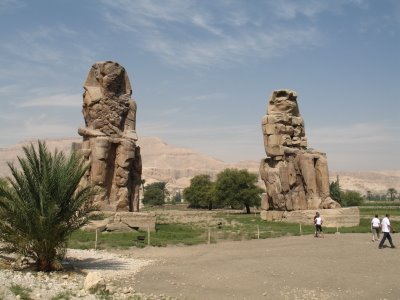Egypt: Floating Down the Nile (updated!)
(At last, blogger worked out their bugs. Here's the long-promised first batch of Egypt photos)
Our time in Egypt began in earnest on the second day. The attendant on our sleeper train brought us breakfast around 6:30, and we pulled into Luxor about a half hour later. Eschewing the taxis and touts, we shouldered and dragged our bags into town and towards the Nile, on the assumption that our boat was more likely to dock there than downtown.
Logic was with us that morning, as after a short time we found the Nile Admiral, which would be our home for the next three days. Since the building of the great dam (more about that later) the Nile is ideal for small cruise ships, and they are so popular that the Egyptian government recently placed a ban on new vessels- over 500 of these tiny mobile hotels now ply the great river, mainly between Luxor and Aswan. Since there are a few noteworthy sites between these two cities, big stretches of not-much-to-interest-the-tourist in between, and vast desert on either side of the river, having a hotel that moves you to the various sites is ideal.
Here you see us on the sun deck, delighted to have found our berth and eager to hit the sights.

Let me immediately confess how positively decadent it felt to travel this way, especially having come from the teahouses of the Annapurna in Nepal less than two weeks earlier. The ship had wonderful rooms, decent food occasionally drifting towards good, a full bar and swimming pool. Afternoon tea served promptly at 4. Nice ping pong table, too.
Nathalie and I headed to the Luxor museum, which of course was smaller than the incredible and exhaustive Egyptian museum in Cairo which we'd be seeing a few days hence, but contained several incridible artifacts, including a large cache of breathtaking statuary discovered in the 1980's during renovation work on Luxor temple: dozens of huge religious statues in the classical styles that looked like they were completed yesterday.
We also took in the mummification musuem, a minor sight but a good one, and very fun. All sorts of sacred animals were mummified, too, it turns out. My theory is the fish were done just to let the newbies practice.
 In the afternoon, our tour with the ship's guide began. Our first stop was a tour of the ruins of Karnak, now a village just north of the city of of Luxor, but once the religious center of Egypt. The original temple structure was begun during the reign of Ramses III (1184-1153), but various rulers added to the complex over the next 1500 years- in some cases struggling to obscure or minimize the works of their predecessors and former rivals.
In the afternoon, our tour with the ship's guide began. Our first stop was a tour of the ruins of Karnak, now a village just north of the city of of Luxor, but once the religious center of Egypt. The original temple structure was begun during the reign of Ramses III (1184-1153), but various rulers added to the complex over the next 1500 years- in some cases struggling to obscure or minimize the works of their predecessors and former rivals.The approach to the complex is dominated by two great pairs of pylons. These are the rows of ram sphinxes between the first and second pairs of pylons. The pylons themselves are massive. The ancient Egyptians built these by creating huge dirt mounds behind the structures and slowly adding to the mounds as the pylons climbed higher.

Below we see the great Hippostyle hall of the temple of Amun. I must have taken fifty photos of these columns, but nothing could come close to capturing what it feels like to stand among them. They are perfect, graceful and intimidating, and they are so clearly very, very old. They’re contained in what, on their scale, is a confined, enclosed space, so there’s no angle from which you can capture their grandeur, and of course, that’s the point. You’re supposed to feel small. It works great.
 This time with Nathalie, not just for scale:
This time with Nathalie, not just for scale:
There are tons of magnificent structures at Karnak, enough that I could easily fill a blog entry on this site alone. Here you see one of the two great obelisks. There’s other temples, chapels, statues and a small artificial lake, too. But the day was not over, as we headed back into town to Luxor temple itself.
Here’s Luxor from the outside.

And just a few minutes later after the sun went down, here's the interior:
 Then we went back to the boat for dinner (competent if not inspiring) and blessed sleep. We'd been on the go since before 7 and had taken in two museums and two major temple complexes that day. Also, did I mention Egypt was hot? Somewhere in the neighborhood of 85 F and sunny. There were a handful of wispy clouds in Luxor, but they'd be the last we saw until we were back in Europe.
Then we went back to the boat for dinner (competent if not inspiring) and blessed sleep. We'd been on the go since before 7 and had taken in two museums and two major temple complexes that day. Also, did I mention Egypt was hot? Somewhere in the neighborhood of 85 F and sunny. There were a handful of wispy clouds in Luxor, but they'd be the last we saw until we were back in Europe.The Valley of the Kings was of course one of the highlights of the trips, where we headed early the next morning. This is (with good reason) one of the spots where cameras are forbidden, so of course I have only exterior shots to show you, which is a shame because the real attraction is all underground. The tombs here were very impressive, and the starkness of the desert valley walls seems impossibly bleak. If anyplace so bathed in sunshine could make you think of death more, I wouldn't want to go there. There are dozens of tombs here, and most surprising to me, more are being discovered all the time. The Egyptian government's head of antiquities has said he believes that three quarters of Egypt's ancient treasures are still under the sand somewhere. If you've never seen the Egyptian Museum in Cairo, they've already got a lot of amazing stuff, much of it from here.
 We only had time to tour three of the tombs. Here's where being on the organized tour from the boat began to sting a little bit. Despite the excellent guide and convenience of not having to arrange all the transporation, it's bitter when you've travelled this distance and you only get a short time in a site like this. I can see why many people like to spend an hour here and no more. To be frank, there is a fair amount of similarity in the various tombs. But all the examples we saw were fascinating and beautiful, and unique enough to make me wonder about the next ten or twenty. It's especially frustrating when a half hour that day was wasted on opportunities to spend money. Ah well, travel is a series of compromises, I think.
We only had time to tour three of the tombs. Here's where being on the organized tour from the boat began to sting a little bit. Despite the excellent guide and convenience of not having to arrange all the transporation, it's bitter when you've travelled this distance and you only get a short time in a site like this. I can see why many people like to spend an hour here and no more. To be frank, there is a fair amount of similarity in the various tombs. But all the examples we saw were fascinating and beautiful, and unique enough to make me wonder about the next ten or twenty. It's especially frustrating when a half hour that day was wasted on opportunities to spend money. Ah well, travel is a series of compromises, I think.After the valley we saw the nearby temples of Hatshepsut, one of the most fascinating characters in Egyptian history. As queen, she outlived her husband and sat as regent over the empire while her son grew, then stayed on the job even after he'd become old enough to run affairs himself (that decision would cause her grief later). But she was a strong ruler, and started many important public works, including this large temple near the Valley of the Kings.
 The structure is set amongst a sheer wall of imposing rock, which frames the temple's columns like a frame around a painting. Many of the temple walls here depict her diplomatic and trade missions to neighboring lands.
The structure is set amongst a sheer wall of imposing rock, which frames the temple's columns like a frame around a painting. Many of the temple walls here depict her diplomatic and trade missions to neighboring lands.
Here we see the 18-meter high Colussi of Memnon. Its believed that these are the only surviving structures of a much larger complex, now given over to papyrus fields. The descriptions of that temple complex (built by Amenhotep III as his funerary temple) make it sound like a lost wonder of the world: doors of electurm and floors of gold and silver.

Then back to the ship for a night of cruising down the mighty river. Our next port of call would be Edfu, to see the great temple of Horus. The eighty kilometers to the south wouldn't take long to cover, but the wait at the locks was substantial as a seemingly endless parade of cruise ships waited their turn.


1 Comments:
Hey U Pat! i know alot about Egypt and i did a projet on it in school!
Post a Comment
<< Home